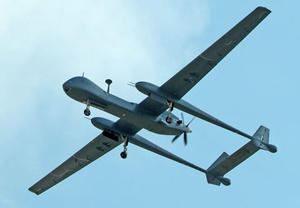Israel's latest UAV -- world's largest -- is no game changer
On Sunday Israel has unveiled the Eitan, the world’s largest UAV (it has the wingspan of Boeing 737); it will undoubtedly allow the country to look deep inside Iran to provide detailed intelligence, but it is not likely to be a wonder weapon to knock out the Islamic Republic’s nuclear facilities

The Eitan has the wingspan of a Boeing 737 // Source: defense-update.com
We wrote the other day about the Israel Air Force’s (IAF) demonstration of the world’s largest UAV (it is the size of a Boeing 737). The IAF did not say what would be the missions of the giant UAV except to state that it “has the capability to reach the [Persian] Gulf.”
UPI reports that Israel’s new monster UAV will undoubtedly allow the country’s military chiefs to look deep inside Iran to provide detailed intelligence, but it is not likely to be a wonder weapon to knock out the Islamic Republic’s nuclear facilities.
The IAF formally inducted the Heron TP — dubbed the “Eitan,” which is the Hebrew word for “strong” — into its inventory Sunday, announcing that it had the range to operate over Iran.
The inference appeared to be that like its Israeli and U.S. counterparts blasting militants in the Gaza Strip, Iraq, Afghanistan, and Pakistan, this 4.5-ton pilotless behemoth would add significant firepower to any Israeli pre-emptive strike against Iran’s nuclear infrastructure without endangering pilots.
That was certainly what the media picked up on, but in its current configuration, the Eitan, built by state-owned Israel Aerospace Industries (IAI), is primarily designed to conduct long-endurance, high-altitude electronic surveillance missions well above commercial air traffic.
“With 24- to 36-hour endurance and the ability to operate above 40,000 feet, the Eitan certainly provides a noteworthy new capability for Israel,” according to the U.S. global security consultancy Stratfor. “But the UAV is something IAI has long been capable of designing and producing and it does not materially alter Israel’s ability to strike Iran.”
Stratfor noted that although the Eitan could reach Iran it would have to fly through Iraqi airspace to get there but that is “the most politically sensitive” route “since it likely would upset the delicate balance of power the United States is trying to help create with March 7 elections.”
The Israeli craft also “does not have the capability to fly around the Arabian Peninsula, reach Iran and return to Israel.”
UPI notes that the Eitan is the biggest UAV in the Israeli arsenal. It is 79 feet long with a wingspan of 86 feet, roughly the wingspan of a Boeing 737 airliner. It has a powerful 1,200-horsepower turbo-prop engine and can carry a 1-ton payload.
For surveillance missions this would comprise a suite of electronic systems, targeting hardware, sensors and cameras, although presumably it could carry weapons to make it an attack UAV.
In terms of endurance, the Eitan has roughly the same capability as the U.S. MQ-9 Reaper, the latest variant of the Predator UAV that has been used to eliminate leaders of al-Qaida and the Taliban with salvos of AGM-114 Hellfire ground-to-air missiles.
The Reaper, built by General Atomics Aeronautical Systems and operated by the Central Intelligence Agency and the U.S. Air Force, is designed as a hunter-killer. “While there is little doubt the Eitan can be fitted with Hellfire missiles and perhaps even configured to carry 500-pound bombs, Israel’s challenge is delivering 5,000-pound bunker-busters to Iran in order to damage key nuclear facilities,” Stratfor noted. “Another challenge for Israel is sustaining an air campaign at that distance over a week’s time when political circumstances and Iranian reprisals could limit Israel to much less.”
With maximum takeoff weight of 4,650 kg, the 14-meter long aircraft can carry over 1,000 kg of sensors in its forward section, main payload bay, and the two bulges located at the end of each tail boom, offering optimal separation for specific systems. For comparison, a B52 can carry about 70,000 pounds (33,000 kg) worth of bombs and a B1 bomber about 40,000 pounds. It would thus take 35 Eitan UAVs to equal the bomb load of a B52.
Intelligence and surveillance would play a vital role in any strike the Israelis might mount if the political decision to attack Iran was made. Analysts say the Eitan would be useful in providing accurate bomb damage assessment, an important element in the kind of military operation the Israelis would have to mount against Iran.
The Eitan actually began flying three years ago but was basically designed for the export market where Israel is a world leader in UAV technology. The Heron TP was sold to France as a Predator substitute, since the waiting list for the U.S. craft was so long — and still is — that the French military needed a UAV system urgently for its forces in Afghanistan.
They currently operate three Heron TPs, renamed Harfangs acquired in 2009, and a fourth is on order.
